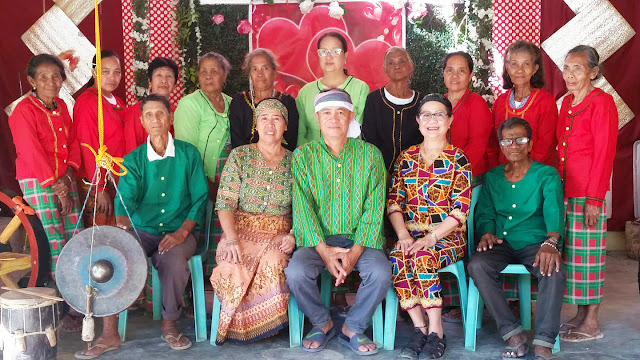The Tagbanua Tribe
 |
| Seated L-R: Orancaya Rodenio Saco, Ba'e Estela M. Joya, Masikampo Ruben C. Joya, Usba e't Masikampo Leah Joya |
The Tagbanua today. They stick to "ugali," tradition, and the moral rules of "adat," customary law. Magellan's secretary, Pigafetta, observed the practice of blood brotherhood ritual in 1521 just as I did myself in 2009. The chief is named Masicampo. On the picture, he appears with his wife. Her function as the ba'e has even been recorded in early Spanish logs. So this is a pre-colonial cultural tradition still very much alive in the southern Philippines. It has many affinities with lifeways in other parts of Southeast Asia, above all, with Borneo. The lady on the right hand flank of the second row, Dominica, is a chief dancer. She has played an important role in my project, above all, in the translation of ritual speech. A Palawan collection in the Oslo University Museum of Cultural History now holds most of the material culture items on the picture, including the traditional wear. It is great luck that an inventory named Consul Holmensen's Collection, originating in the same area of South Philippines, arrived at the museum exactly one hundred years earlier. Along with the Lumholtz collection from Borneo, the museum has ample resources for showing cultural styles in the Austronesian speaking areas of Southeast Asia.
Copied from Dr. Arne Rokkum's Facebook post. He is an antrophologist from Norway who has done research about the Tagbanua tribe.



**"This is an insightful post about the Tagbanua tribe! 🌿 Their deep connection to nature and dedication to preserving Palawan’s beauty is truly inspiring. As stewards of some of the most breathtaking locations from Coron to El Nido, their role in sustainable tourism and marine conservation is crucial.
ReplyDeleteWe recently wrote a short post about the Tagbanua Palawan, exploring their impact on diving tourism and conservation in some of the best diving Philippines sites. If you're interested, feel free to check it out here: https://bestdivingphilippines.com/tagbanua-palawan-guardians/ 🌊🐠
Looking forward to learning more about the Tagbanua and their cultural heritage!"**